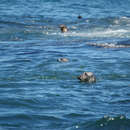Diagnostic Description
provided by FAO species catalogs
Grey seals are robust and sexually dimorphic; males grow noticeably larger, with a proportionately larger and broader head. The distinctive muzzle is particularly long, and wide at the end, with a fleshy mystacial area that somewhat obscures the lower jaw. In adult males, the top of the muzzle is convex. In adult females and subadults, it is flat, very slightly convex (as in adult males), or slightly concave; the latter having only a barely noticeable forehead. The shape of the head has led to the locally used common name "horsehead". The nostrils are widely separated and almost parallel to each other, forming almost a W-pattern as opposed to the Vshaped pattern of seals of the genus Phoca. The eyes are small in proportion to the size of the head and somewhat widely separated. The foreflippers are short, on adult males, and are wide and relatively thick. Typically, adult males are somewhat thicker through the neck than females. Pelage colour and pattern are individually variable. Most grey seals are shades of grey, slightly darker above than below. There are usually numerous irregular blotches and spots on the back and sometimes a few below. Many males darken with age. Subadults are paler, with few, if any, blotches; some are light tan just prior to moult. Others are orange to reddish on the neck, underside, and flippers. Newborns have a silky, creamy white lanugo, occasionally with a greyish tinge. In 2 to 4 weeks, this coat is replaced by one like that of the female, but with more subtle markings. The dental formula of adults is I 3/2, C1/1 ,PC 5-6/5. Can be confused with: Five phocids share the grey seal's range. The grey seal is larger, with a relatively larger head and longer muzzle, and a decidedly different set of pelage markings than harbour seal, harp seal , and ringed seal. The characteristics of the head, muzzle, and nose, and overall colour and markings will help separate grey seals from the comparably sized bearded seal and hooded seal.
- bibliographic citation
- Marine mammals of the world. Jefferson, T.A., S. Leatherwood & M.A. Webber - 1993. FAO species identification guide. Rome, FAO. 320 p. 587 figs. .
- author
- Food and Agriculture Organization of the UN
Size
provided by FAO species catalogs
Adult males are up to 2.3 m long and weigh 170 to 310 kg, females to 2 m and 105 to 186 kg. Pups are 90 to 105 cm and 11 to 20 kg at birth.
- bibliographic citation
- Marine mammals of the world. Jefferson, T.A., S. Leatherwood & M.A. Webber - 1993. FAO species identification guide. Rome, FAO. 320 p. 587 figs. .
- author
- Food and Agriculture Organization of the UN
Brief Summary
provided by FAO species catalogs
Grey seals are polygynous. Males actively compete for females, but actually fight little, relying instead on threat gestures and vocalizations. They do not defend territories or herd females. Pupping and breeding occur between late September and early March. Seals in the British Isles breed earliest, followed by those in Norway and Iceland, and finally those off Canada and in the Baltic Sea. Grey seals disperse widely from their rookeries during the non-breeding season, but reassemble to moult. When ashore, they are generally gregarious, hauling out near each other, as well as with harbour seals. In the water they are usually solitary, or in small dispersed groups. They regularly maintain a vertical "bottle" position, treading water with only the head exposed.Grey seals feed in inshore benthic habitats, on a wide variety of fishes and invertebrates. They also feed on schooling fish in the water column, and occasionally take seabirds.
- bibliographic citation
- Marine mammals of the world. Jefferson, T.A., S. Leatherwood & M.A. Webber - 1993. FAO species identification guide. Rome, FAO. 320 p. 587 figs. .
- author
- Food and Agriculture Organization of the UN
Benefits
provided by FAO species catalogs
Grey seals have been the target of subsistence hunting, followed by commercial hunting and, finally, government-sponsored culls to control their numbers as pests to fisheries. IUCN: Insufficiently known.
- bibliographic citation
- Marine mammals of the world. Jefferson, T.A., S. Leatherwood & M.A. Webber - 1993. FAO species identification guide. Rome, FAO. 320 p. 587 figs. .
- author
- Food and Agriculture Organization of the UN

